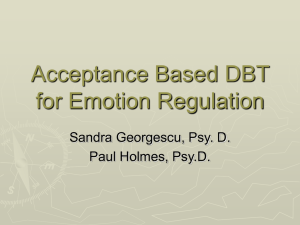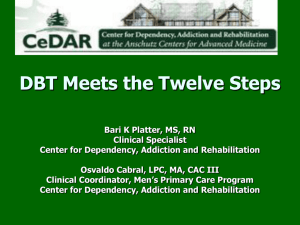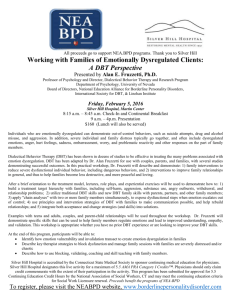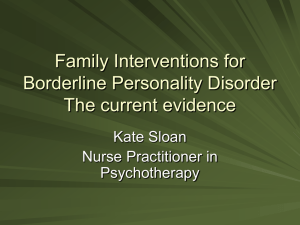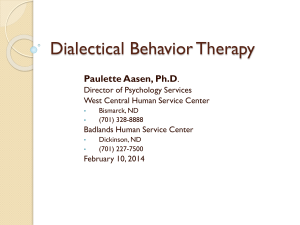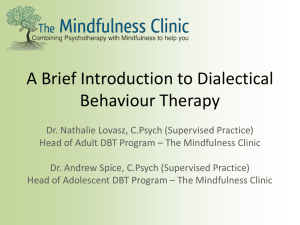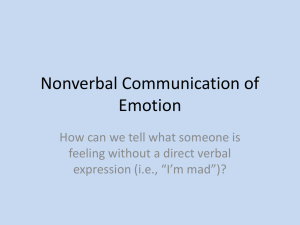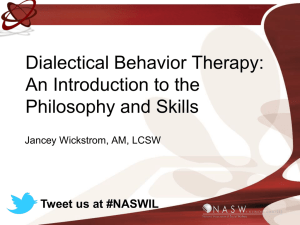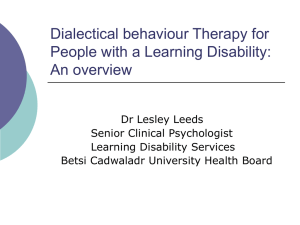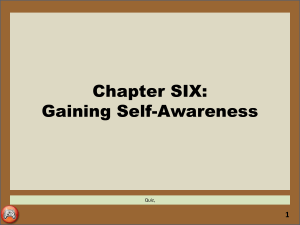Dialectical Behavior Therapy
advertisement
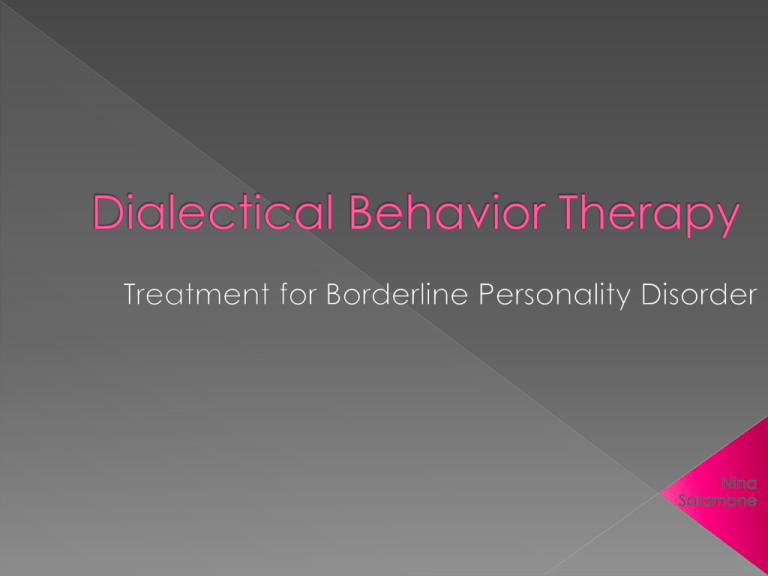
EMOTION DYSREGULATION Emotional Lability (Frequent Mood Changes) Problems with Anger INTERPERSONAL DYSREGULATION Chaotic Relationships Fears of Abandonment SELF DYSREGULATION Confused sense of self (e.g., not knowing where they fit in) Sense of Emptiness BEHAVIORAL DYSREGULATION Suicidal and Self-Injurious Behaviors/Threats Impulsive Behavior (e.g., alcohol/drug abuse, binge eating, stealing) COGNITIVE DYSREGULATION Paranoid Thoughts Dissociative Responses High Emotion Vulnerability High Sensitivity -immediate reactions -low threshold for emotional reaction High Reactivity -extreme reactions -high arousal dysregulates cognitive processing Slow return to baseline -long-lasting reactions -contributes to high sensitivity to next emotional stimulus Biological Vulnerability + an Invalidating Environment INVALIDATION means to DENY another person’s take on a situation or to JUDGE it. Examples of INVALIDATION include: “How can you feel that way?” “That makes no sense.” “That is so stupid.” “You are so selfish.” “You have no reason to be upset.” Thoughts, feelings, perceptions are met with inconsistent, inappropriate, and extreme responses from environment. The individual learns to believe that they are wrong to have those thoughts, feelings, perceptions. The consequences of invalidating environments are severe. The individual does not learn to: • • • • • • • Label feelings accurately, Regulate emotion skillfully, Trust their reactions (Self-invalidation), Effectively tolerate distress, Achieve long-term goals, Form realistic goals and expectations, Express emotion appropriately. Dialectical behavior therapy (DBT) is a specialized form of cognitive-behavioral therapy. It was originally developed to treat adults and adolescents demonstrating intense mood swings; relationship difficulties ; frantic efforts to avoid abandonment ; confused thinking; impulsive behavior ; and recurrent suicidal behaviors including suicidal ideation, intentional self-injury, and history of multiple suicide attempts. DBT Includes: 1. Weekly Individual DBT Sessions In individual DBT, the client and primary therapist begin by establishing a committed, collaborative working relationship while clearly defining the client’s treatment goals. A comprehensive behavioral assessment is completed that includes past and current history of problematic behaviors, prior treatment experiences and life goals. 2. Weekly DBT Skills Training In weekly 90-minute DBT Skills Groups, the focus is on learning and mastering four skills modules which include core mindfulness skills, distress tolerance skills, emotion regulation skills, and interpersonal effectiveness skills. 3. Between-Sessions Phone Coaching Phone or e-mail consultation between sessions with the primary therapist is encouraged in DBT. Calls or e-mails to the primary therapist focus on decreasing suicide crisis behaviors; increasing skillful behaviors in everyday life; and resolving interpersonal crises, alienation, or a sense of distance between the client and the therapist 4. DBT Consultation Team In DBT, there is a strong emphasis on a team-approach to treatment. DBT therapists commit to obtaining weekly case consultation with colleagues within a treatment team meeting format. The goal is to maintain adherence to DBT principles and to conduct caring, compassionate, competent and effective therapy. Decrease: Life-threatening behaviors (e.g., overdosing, cutting, making suicide threats) Therapy-Interfering behaviors (e.g., not completing diary cards, missing sessions, not telling the truth) Quality-of-Life Interfering behaviors (e.g., using drugs & alcohol, binging/restricting food, risky behaviors) Increase: Behavioral Skills Mindfulness Distress Tolerance Emotion Regulation Interpersonal Effectiveness & Middle Path Skills Being in control of your mind instead of letting your mind be in control of you. Controlling what you pay attention to and how long you pay attention to it. Focusing on one thing at a time and staying in the moment. Awareness. Just noticing the experience. Being fully mindful and aware can help you “think before you act” and avoid impulsive and destructive behaviors you may later regret. Mindfulness increases choices. Once you are aware that you have an impulse, you can decide to act on the impulse or choose another course of action. Mindfulness is often the first step towards using skills. Skills will work better when you use them in a mindful way and focus all your attention on them Reasonable Wise Mind Mind Emotion Mind Emotional Mind How do you know you’re in Emotional Mind? • You may be experiencing intense emotions such as anger, sadness, fear, frustration, guilt, envy, or joy. • It may take very little to trigger an emotional reaction. • You may be quick to react to emotional triggers. • Your reactions may be extreme. • It may take a long time for your intense emotion to pass. • Cool, rational, task-focused, fact-focused. • Reason based on intellect. • Reasonable Mind sometimes tries to squash Emotion Mind with facts and reason (e.g., “Just figure it out. Get over it.”). In this way, it can be invalidating to emotional responses. • Reasonable Mind decisions may be practical, but may make you feel like you’re “settling” for something you don’t completely want. A Wise Mind Involves: Taking in the whole of a situation – including observable facts, your emotions and values, other people’s feelings and points of view, and possible consequences of behavior. Using this information to make a wise or effective decision about what you should do, how you can view the circumstances, and how to take care of your emotions. “What” Skills & “How” Skills “What” skills (Observe, Describe, Participate) “How” skills (Non-judgmentally, One-mindfully, Effectively) “What” skills tells us what kinds of things we need to do during mindfulness practice to help us reach our wise mind. These behaviors also describe what we do when we are actually in Wise Mind. Observe Describe Participate Observe Describe Put words to your observed pure sensation experience. without Observe your experience at the level of getting caught in it and without putting words to it. Participate Take part in an activity with awareness. Stay in the moment and notice what you are doing, feeling, thinking, etc. After noticing these things, don’t increase, decrease, or change the behavior. Continue to carry on with (participate in) what you are doing. Participation involves: Spontaneity and flow Letting go of selfconsciousness Becoming “one” with the activity “How” skills tells us how to accomplish the “What” skills. In other words, “How” skills provide us with tips as to how we should attempt to observe, describe, and participate when we are practicing mindfulness and when we are in Wise Mind. Non-judgmentally One-mindfully Effectively Non-Judgementally One-Mindfully Effectively Don’t evaluate. Unglue opinions from facts. Just acknowledge what’s happening. Accept each moment as is. Avoid using judgment words as a short-hand for descriptions. Instead of saying “stupid”, “bad”, or “weird”, ask yourself, “What do I mean by that descriptively?” When you find yourself judging, don’t judge your judging. Non-judgmentally does not mean approval. Doing one thing at a time with awareness by bringing your entire attention to this moment. Doing what you need to do to accomplish your goals. Acting based on what will work best in the long run, rather than what will make you feel better in the short run. Acting as skillfully as you can in the situation you’re actually in, not the one you wish you were in. Asking yourself, “Would I rather be ‘right’ or get what I want?” Acting with your Wise Mind, rather than your Emotion Mind. Letting go of anger, vengeance, and ego. Playing by the rules. If other actions, thoughts, or strong feelings distract you, let go of these distractions and return to what you are doing again and again. “It’s a crisis! What do I do ?” What is it? Learning to use skills to increase the ability to tolerate/accept distress and to bear pain more effectively. Purpose? Distress Tolerance skills work toward tolerating and surviving crises and with accepting life as it is in the moment because pain and distress are part of life. Activities: I might walk my dog to distract myself so with time I will calm down and let my emotional distress pass. Contributing: Doing something nice for someone else. Cooking dinner for the family. Sending a card to a friend that might need a “pick me up.” Comparisons: Comparing yourself to those less fortunate than you. Some people are misdiagnosed and need DBT and are in therapy that is ineffective. Comparing yourself to others whose family does not support them and refuse to attend the family group. Emotions: Creating emotions that are opposite to your current emotional state. If you are very angry, listening to calming music or watching a funny movie. Pushing Away: To put intense emotions or difficult situations “on a shelf” for a little while… until you can think and problem-solve more calmly. Thoughts: Creating other thoughts to fill up your mind rather than ruminating which can lead to escalation of a distressing situation. Play a word game like Scrabble, crossword puzzles, or just counting anything . Sensations: Create other sensations rather than acting on a behavior. Hold an ice cube until it melts. Put a cold cloth on your forehead or a very warm cloth. Have emergency breakable hot or cold packs in your car. Jump into an ice-cold shower. Vision: Go outside and look at the stars, pick a pretty flower, decorate your room, look at beautiful scenic pictures, paint your nails. Hearing: Listen to music that is soothing or that lifts your mood. Go outside and hear your chimes on your porch, or the wind blowing. Smell: Light some scented candles, spray your favorite perfume, put on scented lotion, or bake some cookies just for the aroma! Taste: Make a cup of tea, or have a piece of peppermint candy. Touch: Change your sheets, take a bubble bath, put on comfy pajamas, blow bubbles & run and catch them. Imagery: Imagine yourself well. Make up a fantasy world where all is peaceful and beautiful. Meaning: Making lemonade out of lemons. Prayer: Ask for strength Relaxation: Muscle relaxation, yoga, calming music, deep breathing, half-smile. One thing in the moment: Focus your entire attention on what you are doing right now. When washing dishes, focus all your attention on the task. With a brief Vacation: Taking a nap, or turning your cell phone off for a day. With Encouragement: “I know I can get through this.” Pros and Cons Thinking of the advantages and disadvantages of doing a harmful behavior. Focus on the light at the end of the tunnel. Remember times when you felt better. Goal is to do what works in the short-term and long-term! Radical Acceptance Freedom from suffering requires acceptance from deep within of what is. Pain creates suffering only when you refuse to accept the pain. To accept something does not mean to acknowledge it as good. Deciding to tolerate the moment is Acceptance Turning the mind An Act of Choice”-you have to turn your mind toward the acceptance road and away from the rejecting road. The commitment to accept does not equal acceptance- it just turns you towards the path. Willingness Willingness is doing just what is needed. It is focusing on being “effective.” Willingness is listening to your Wise mind, acting from your inner self. The Goal of Emotion Regulation is to Reduce Suffering + Increase Happiness Myths About Emotions • • • • There is a right way to feel in every situation. Negative feelings are bad and destructive. Other people are the best judge of how I am feeling. Painful emotions are not important and should just be ignored. Staying out of “Emotion Mind” Remember the ABC’s ACCUMULATE POSITIVE EMOTIONS SHORT -TERM: Do pleasant things that are possible now. LONG -TERM: Make changes in your life so that positive events will occur more often. Build a “Life Worth Living.” BUILD MASTERY Do at least one thing each day to build a sense of accomplishment. Plan for success, not failure. Do something difficult, BUT possible. Gradually, increase the difficulty over time. COPE AHEAD OF TIME WITH EMOTIONAL SITUATIONS Rehearse a plan ahead of time so that you are prepared to cope skillfully with emotional situations. Decide what coping skills you want to use in the situation. Be specific. Imagine the situation in your mind as vividly as possible. Imagine yourself IN the situation and rehearse in your mind coping effectively. OPPOSITE ACTION WORKS WHEN 1. The emotion or the intensity or the duration of the emotion is NOT JUSTIFIED by the facts of the situation (the emotion does not fit the situation). 2. The emotion or the intensity or the duration of the emotion is NOT EFFECTIVE for the situation. 1. 2. 3. 4. 5. CHECK THE FACTS to be sure your emotional reaction in not justified or is not effective for the situation. IDENTIFY ACTION URGES associated with your emotion. ACT OPPOSITE to your urges—do opposite action ALL THE WAY. CONTINUE opposite action until your emotion goes down. REPEAT…over and over, every chance you get. OBJECTIVES EFFECTIVENESS Getting the “thing” I want When it’s your legitimate right. Getting another to do something for you. Refusing an unwanted or unreasonable request. Resolving an interpersonal conflict. Getting your opinion or point of view taken seriously. RELATIONSHIP EFFECTIVENESS Getting and Keeping a Good Relationship Acting in such a way that the other person keeps liking and respecting you. Balancing immediate goals with the good of the long-term relationship. Remembering why the relationship is important to you now and in the future. SELF-RESPECT EFFECTIVENESS Keeping or Improving Self-Respect and Liking for Yourself Respecting your own values and beliefs: acting in a way that makes you feel moral. Acting in a way that makes you feel capable and effective. Describe: Tell the person exactly what you are reacting to…..stick to the facts. Express: Express your feelings and opinions about the situation. Use phrases such as “I want” and “I don’t want,” instead of “I need,” “you should,” or “I can’t.” Assert: Assert yourself by asking for what you want or Saying No clearly. Assume that others will not figure it out or do what you want unless you ask. Assume that others cannot read your mind. Don’t expect others to know how hard it is for you to ask directly for what you want. Reinforce: Reinforce or reward the person ahead of time by explaining the consequences. Tell the person the positive effects of getting what you want or need. Tell him or her (if necessary) the negative effects of your not getting it. Help the person feel good ahead of time for doing or accepting what you want. Reward him or her afterwards. (stay) Mindful: Keep your focus ON YOUR OBJECTIVES. Maintain your position. Don’t be distracted. Appear confident: Appear EFFECTIVE and competent. Use a confident voice tone and physical manner; make good eye contact. No stammering, whispering, staring at the floor, retreating, saying, “I’m not sure,” etc. Negotiate: Be willing to give to get. Offer and ask for alternative solutions to the problem. Reduce your request. Maintain no, but offer to do something else or to solve the problem another way. Focus on what will work. (Be) Gentle Be courteous and temperate in your approach. No attacks, No threats, No judging (Act) Interested LISTEN and be interested in the other person. Validate Validate or ACKNOWLEDGE the other person’s feelings, wants, difficulties and opinions about the situation. Be nonjudgmental out loud: I can understand how you feel, but…”, “I see that you are busy, and…” (Use an) Easy manner Use a little humor. SMILE. Ease the person along. Be light-hearted. Wheedle. Use a “soft sell” over a “hard sell.” Be political. (Be) Fair Be fair to YOURSELF and to the OTHER person. (NO) Apologies No OVERLY apologetic behavior. No apologizing for being alive, for making a request at all. No apologizing for having an opinion, for disagreeing. Stick to Values Stick to YOUR OWN values. (Be) Truthful DON’T LIE, ACT HELPLESS when you are not. Don’t EXAGGERATE. Don’t make up excuses. The goals of this module are to help group members effectively manage family dilemmas by using: Dialectics: Balancing Acceptance and change, and “walking the middle path” Validation: Working on acceptance Behaviorism: Working on change Dialectics teaches us that: There is always more than one way to see a situation, and more than one way to solve a problem. All people have unique qualities and different points of view. It is important not to see the world in “black-and-white,” “allor-nothing” ways. Two things that seem like (or are) opposites can both be true. Change is the only constant. Meaning and truth evolve over time. Change is transactional. A “life worth living” has both comfortable and uncomfortable aspects (happiness AND sadness; anger AND peace; hope AND discouragement; fear AND ease; etc). Validation communicates to another person that his or her feelings, thoughts, and actions make sense and are understandable to you in a particular situation. REMEMBER: Validation ≠ Agreement Self-validation involves perceiving your own feelings, thoughts, and actions as accurate and acceptable in a particular situation. When you validate another person: • It shows that you are listening. • It shows that you are trying to understand them. • It can decrease the intensity of conflicts. • It communicates respect. When you validate yourself: • It helps you get out of Emotion Mind and into Wise Mind. • It helps you take your own point of view seriously. Behaviorism is a set of strategies or principles used to increase behaviors we do want and reduce behaviors we don’t want (in our selves and others). Reinforcers: Consequences that result in more of a behavior. Reinforcers provide information to a person about what you want that person to do. Positive reinforcement: Increases the frequency of a behavior by providing a rewarding consequence (e.g., praise, a compliment, or an A on an exam). Negative reinforcement: Increases the frequency of a behavior by removing a negative consequence. Examples: taking aspirin to get rid of a headache, doing homework to get Mom to stop nagging, or selfcutting to decrease or avoid negative feelings (although DBT teaches skills to manage this better).
